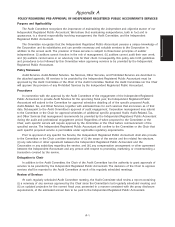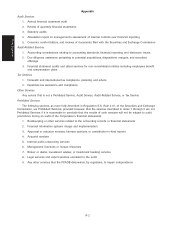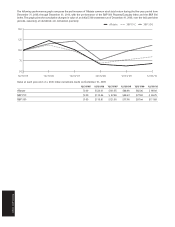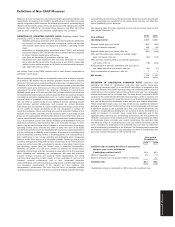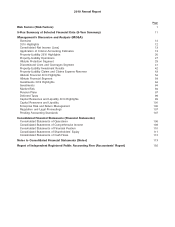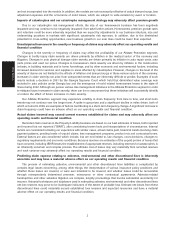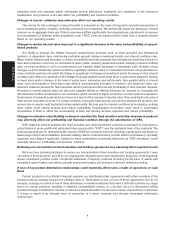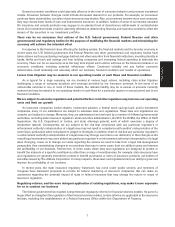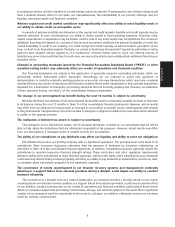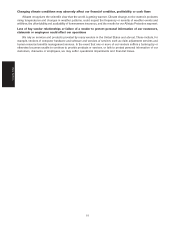Allstate 2011 Annual Report Download - page 82
Download and view the complete annual report
Please find page 82 of the 2011 Allstate annual report below. You can navigate through the pages in the report by either clicking on the pages listed below, or by using the keyword search tool below to find specific information within the annual report.
and not incorporated into the models. In addition, the models are not necessarily reflective of actual demand surge, loss
adjustment expenses and the occurrence of mold losses, which are subject to wide variation by event or location.
Impacts of catastrophes and our catastrophe management strategy may adversely affect premium growth
Due to our catastrophe risk management efforts, the size of our homeowners business has been negatively
impacted and may continue to be negatively impacted if we take further actions. Homeowners premium growth rates
and retention could be more adversely impacted than we expect by adjustments to our business structure, size and
underwriting practices in markets with significant catastrophe risk exposure. In addition, due to the diminished
potential for cross-selling opportunities, new business growth in our auto lines could be lower than expected.
Unanticipated increases in the severity or frequency of claims may adversely affect our operating results and
financial condition
Changes in the severity or frequency of claims may affect the profitability of our Allstate Protection segment.
Changes in bodily injury claim severity are driven primarily by inflation in the medical sector of the economy and
litigation. Changes in auto physical damage claim severity are driven primarily by inflation in auto repair costs, auto
parts prices and used car prices. Changes in homeowners claim severity are driven by inflation in the construction
industry, in building materials and in home furnishings, and by other economic and environmental factors, including
increased demand for services and supplies in areas affected by catastrophes. However, changes in the level of the
severity of claims are not limited to the effects of inflation and demand surge in these various sectors of the economy.
Increases in claim severity can arise from unexpected events that are inherently difficult to predict. Examples of such
events include a decision in 2001 by the Georgia Supreme Court which held that diminished value coverage was
included in auto policies under Georgia law and the emergence of mold-related homeowners losses in the state of
Texas during 2002. Although we pursue various loss management initiatives in the Allstate Protection segment in order
to mitigate future increases in claim severity, there can be no assurances that these initiatives will successfully identify
or reduce the effect of future increases in claim severity.
Our Allstate Protection segment may experience volatility in claim frequency from time to time, and short-term
trends may not continue over the longer term. A spike in gas prices and a significant decline in miles driven, both of
which occurred in 2008, are examples of factors contributing to a short-term frequency change. A significant increase in
claim frequency could have an adverse effect on our operating results and financial condition.
Actual claims incurred may exceed current reserves established for claims and may adversely affect our
operating results and financial condition
Recorded claim reserves in the Property-Liability business are based on our best estimates of losses, both reported
and incurred but not reported (‘‘IBNR’’), after considering known facts and interpretations of circumstances. Internal
factors are considered including our experience with similar cases, actual claims paid, historical trends involving claim
payment patterns, pending levels of unpaid claims, loss management programs, product mix and contractual terms.
External factors are also considered which include, but are not limited to, law changes, court decisions, changes to
regulatory requirements and economic conditions. Because reserves are estimates of the unpaid portion of losses that
have occurred, including IBNR losses, the establishment of appropriate reserves, including reserves for catastrophes, is
an inherently uncertain and complex process. The ultimate cost of losses may vary materially from recorded reserves
and such variance may adversely affect our operating results and financial condition.
Predicting claim expense relating to asbestos, environmental and other discontinued lines is inherently
uncertain and may have a material adverse effect on our operating results and financial condition
The process of estimating asbestos, environmental and other discontinued lines liabilities is complicated by
complex legal issues concerning, among other things, the interpretation of various insurance policy provisions and
whether those losses are covered, or were ever intended to be covered, and whether losses could be recoverable
through retrospectively determined premium, reinsurance or other contractual agreements. Asbestos-related
bankruptcies and other asbestos litigation are complex, lengthy proceedings that involve substantial uncertainty for
insurers. Actuarial techniques and databases used in estimating asbestos, environmental and other discontinued lines
net loss reserves may prove to be inadequate indicators of the extent of probable loss. Ultimate net losses from these
discontinued lines could materially exceed established loss reserves and expected recoveries and have a material
adverse effect on our operating results and financial condition.
2
Risk Factors



